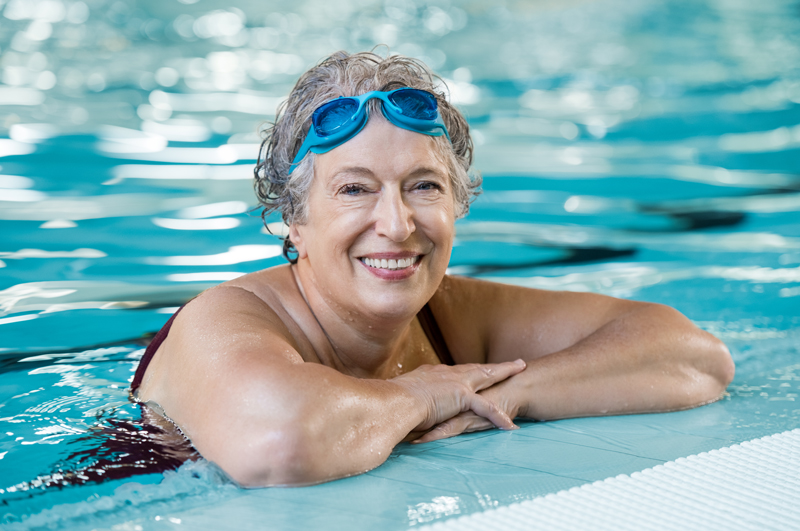Two weeks ago, I wrote about independence and last week talked about the connection between mobility, independence, and health. Today, I’m continuing along those same lines discussing moderate exercise, specifically “life sports” in which most seniors can participate.
Growing up, I played football and tennis and ran track. For two or three summers, I was also on a swim team. Baseball was another sport I tried, but all I accomplished was learning to catch both a bat and ball with my forehead. Can you say ouch? I was never very good at these sports. In fact, disastrous would be a more apt description. The good news is today I am quite active, enjoying moderate weight lifting, jogging and tennis.
I am only 61 (did you see the emphasis), and I know many people, older and younger, who do ZERO physical activity. Many of these individuals are now experiencing problems like heart disease, high blood pressure and obesity, ailments we often associate with a sedentary life style. It’s sad because they are still relatively young. A 2014 study commissioned by the National Institutes of Health (NIH) stated, “physical inactivity is a primary cause of most chronic diseases.” The report was quite exhaustive, citing 579 different articles from a variety of experts. In 2016, Julie Beck, a senior associate editor for the Atlantic, published an article that the Mayo Clinic reported less than 3% of the U.S. population lives a healthy lifestyle.
These two reports were representative of the fact that America is less healthy than other countries. There are, of course, many definitions of “healthy lifestyle,” and we could debate what the correct definition is. We could also debate the percentages. Neither of these is the purpose of this article. I am willing to concede definition and percentage points and agree the United States has a healthy lifestyle problem. Neither of these reports concentrated wholly on seniors. The Mayo Clinic’s findings, summarized by Ms. Beck, studied 4,745 people from 2013 to 2016. The clinic’s study measured thirteen biomarkers including diet, cholesterol level, and blood pressure. No mention was made of specific age groupings, but that it did account for demographic variances. However, if we use only a 3% figure and apply that to a senior population of 50 million, then only 1,500,000 seniors are enjoying a healthy lifestyle and the remaining 48,500,000 are not. That, to me, is significant.
I am neither a scientist nor degreed healthcare professional. My only qualification, if you can call it that, is having transported seniors for ten years. Furthermore, I truly enjoy investing time and energy in that age group. I have no other qualifications. That said, I believe everyone, including seniors, should be more active. The tendency as we age is to be less physically engaged. That said, there are many seniors who are bodybuilders, marathoners, masters swimmers, or golfers. Jack LaLanne was active well into his nineties, but he and others are more the exception than the norm. Most people become less active as they age. I’m not advocating eight hours of daily exercise. Perhaps thirty minutes to an hour. However, if your goal is to run a marathon or become a bodybuilder, be smart about your regimen. You may even opt to work with a trainer. Many places like the YMCA and LA Fitness have group classes. These are a great way to exercise, meet people and stay motivated.
In preparing for this article, I went online to research articles on exercises for seniors. There were, as you can imagine, thousands and each stressed proper form, time, repetitions required, and the associated benefits. Many of these articles were repetitious, but they all had one common them: exercise is good for us. Since I’m not a physician, I will not list all the benefits of exercise but will say that the positives of an active lifestyle far outweigh the negatives of one that is sedentary. Furthermore, let me recommend that if you are embarking on a new exercise routine for the first time or after a prolonged period of inactivity, it may behoove you to first consult your physician.
If you’ve read this far, then you know I do not advocate a sedentary lifestyle. There is little to be gained by being a couch potato. Many seniors have no desire to participate in team sports, even in leagues geared for them. Instead, they just wish to remain active and enjoy a healthy lifestyle. One way to do this is to adopt a lifetime sport. These are sports that “are low-impact and low-risk activities, and they do not involve physical contact with other players. These activities promote fitness and improve health at any age.” A few examples include golf, swimming, walking, bicycling, weight lifting, stretching, water aerobics, yoga and tai chi. Another good activity is gardening. This list is anything but exhaustive. I left out dozens of exercises and several sports or games, examples include bocce ball and shuffleboard. There’s even a game, “pickleball”, that is gaining popularity. Its tennis played with a wiffle-like ball and paddles on a volleyball court. The net is very much like those used in regular tennis. It’s low impact, but quite competitive. There are even tournaments and leagues.
We all wish to remain as independent for as long as possible and the majority of seniors do not want to be a burden on friends or family. The best way to do that is to be as active as possible, participating as best you can and HAVE FUN.
I understand that not all seniors can participate in activities like the ones above. For whatever reason, participation is not an option. There are, though, numerous exercises you can do from a sitting position that will help you remain active and alert. Next week, I intend to explore them. I hope you will join me.


Recent Comments